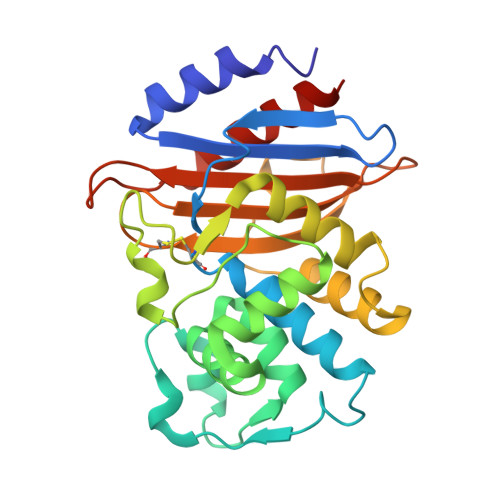Crystal Structures of KPC-2 and SHV-1 beta-Lactamases in Complex with the Boronic Acid Transition State Analog S02030.
Nguyen, N.Q., Krishnan, N.P., Rojas, L.J., Prati, F., Caselli, E., Romagnoli, C., Bonomo, R.A., van den Akker, F.(2016) Antimicrob Agents Chemother 60: 1760-1766
- PubMed: 26729491
- DOI: https://doi.org/10.1128/AAC.02643-15
- Primary Citation of Related Structures:
5EE8, 5EEC - PubMed Abstract:
Resistance to expanded-spectrum cephalosporins and carbapenems has rendered certain strains of Klebsiella pneumoniae the most problematic pathogens infecting patients in the hospital and community. This broad-spectrum resistance to β-lactamases emerges in part via the expression of KPC-2 and SHV-1 β-lactamases and variants thereof. KPC-2 carbapenemase is particularly worrisome, as the genetic determinant encoding this β-lactamase is rapidly spread via plasmids. Moreover, KPC-2, a class A enzyme, is difficult to inhibit with mechanism-based inactivators (e.g., clavulanate). In order to develop new β-lactamase inhibitors (BLIs) to add to the limited available armamentarium that can inhibit KPC-2, we have structurally probed the boronic acid transition state analog S02030 for its inhibition of KPC-2 and SHV-1. S02030 contains a boronic acid, a thiophene, and a carboxyl triazole moiety. We present here the 1.54- and 1.87-Å resolution crystal structures of S02030 bound to SHV-1 and KPC-2 β-lactamases, respectively, as well as a comparative analysis of the S02030 binding modes, including a previously determined S02030 class C ADC-7 β-lactamase complex. S02030 is able to inhibit vastly different serine β-lactamases by interacting with the conserved features of these active sites, which includes (i) forming the bond with catalytic serine via the boron atom, (ii) positioning one of the boronic acid oxygens in the oxyanion hole, and (iii) utilizing its amide moiety to make conserved interactions across the width of the active site. In addition, S02030 is able to overcome more distantly located structural differences between the β-lactamases. This unique feature is achieved by repositioning the more polar carboxyl-triazole moiety, generated by click chemistry, to create polar interactions as well as reorient the more hydrophobic thiophene moiety. The former is aided by the unusual polar nature of the triazole ring, allowing it to potentially form a unique C-H…O 2.9-Å hydrogen bond with S130 in KPC-2.
Organizational Affiliation:
Department of Biochemistry, Case Western Reserve University, Cleveland, Ohio, USA.
















